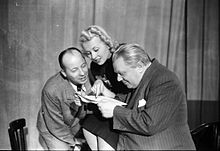Cabaret the comedian

The cabaret of the comedians , often called KadeKo , was a cabaret in what is now Berlin's Charlottenburg-Wilmersdorf district .
history

On December 1, 1924, the actors Paul Morgan , Kurt Robitschek and Max Hansen founded the comedians' cabaret in Berlin . After moving several times (they played first in Kantstrasse , later in a theater on Kurfürstendamm ), a “smoke theater” was opened on September 19, 1928 for 950 visitors in the WOGA complex on Lehniner Platz . In 1932 the first "cabaret opera" was called Call Mr. Plim! performed with the text by Robitschek and Marcellus Schiffer and the music by Mischa Spoliansky .
The " seizure of power " by the National Socialists led to the emigration of Robitschek and several of his employees. The cabaret was directed first by Hanns Schindler , then by Willi Schaeffers . By almost completely dispensing with any kind of time-critical allusions, the KadeKo was able to continue until the general theater opening. Nevertheless, the comedians' cabaret was not free from reprisals either . The cabaret and singing trio Die Drei Rulands was excluded from the Reich Chamber of Culture after an appearance as Die drei Stadtbauarchitekten , in which they targeted the National Socialist plans for the renovation of Berlin , which meant a lifelong professional ban . On August 31, 1944, the cabaret ceased operations with a performance in Café Leon.
After the end of the Second World War, Schaeffers renewed the business, but no longer offered cabaret, but cabaret . In 1965, the piano humorist Günter Neumann founded a “comedian cabaret” in West Berlin , which was also only of modest size.
House newspaper
From December 1925 to 1933 the comedian Die Frechheit appeared as the in-house newspaper of the cabaret . A magazine of humor. At the same time the comedians' cabaret program . The editors were Kurt Robitschek and Paul Morgan.
Artists in the KadeKo (selection)
Many well-known artists performed in the large house on Lehniner Platz ( Kurfürstendamm 156), including:


- Lale Andersen
- Wilhelm Bendow
- Erwin Bootz
- Maria Collm
- Comedian Harmonists
- Max Ehrlich
- Heinz Erhardt
- Werner Finck
- Curth Flatow
- Peter Frankenfeld
- Peter Igelhoff
- Walter Mehring
- Brigitte Mira
- Günter Neumann
- Paul Nicholas
- The three Rulands
- Willy Rosen
- Julius Hans Spiegel
- Karl Valentin
- Lotte foreman
Jürgen Fehling, among others, worked as a director . Almost all of the important emcees of the time could be seen here.
Web links
Individual evidence
- ↑ Peter Frankenfeld : That was my life . 1st edition. FA Herbig Verlagsbuchhandlung, Munich / Berlin 1982, ISBN 978-3-7766-1228-8 , Mensch, Junge, you belong on the stage (352 pages).
- ↑ Großrevuen - From the "Cabaret of the Comedians" to the "Austrian Cavalcades"
- ↑ Dagmar Thorau / Sören Schäfer: This is where the fun ends. The "Germania" planning in cabaret , in: Mythos Germania , Edition Berliner Unterwelten in Chr. Links Verlag, 2017, pp. 98-103, ISBN 978-3-86153-895-0 .
Coordinates: 52 ° 29 ′ 56.5 ″ N , 13 ° 18 ′ 11.4 ″ E